Research on the Characteristics of High-Temperature Heat Waves and Outdoor Thermal Comfort: A Typical Space in Chongqing Yuzhong District as an Example
Abstract
:1. Introduction
2. Materials and Methods
2.1. Methodological Framework
2.2. On-Site Measurement
2.3. Evaluation of Outdoor Thermal Comfort in Summer
2.4. Thermal Comfort Data Statistics and Analysis
3. Results
3.1. Thermal Environment Characteristics of Different Measurement Areas
3.1.1. Thermal Environment Results of Business Areas
3.1.2. Thermal Environment Results of Residential
3.1.3. Thermal Environment Results of Mountain Park
3.1.4. Thermal Environment Results of Riverside Park
3.2. Summer Outdoor Crowd Voting Analysis
3.3. Thermal Comfort Effect Analysis
3.4. Summer Outdoor Thermal Comfort Evaluation Model
4. Discussion
- The results of this study may only apply to mountainous humid-heat regions similar to Chongqing.
- In the measured study, only the outdoor crowd thermal comfort in summer was studied, lacking the winter measured control.
- In the follow-up study, multiple measurements should be conducted in the selected measurement areas to ensure the continuity and accuracy of the data, and further simulation modeling should be used to make the study’s conclusions more accurate.
5. Conclusions
- Urban high-temperature heat waves are related to the distribution of urban spatial environmental elements, high temperature heat waves in mountainous high-density urban spaces show obvious zoning differences and complex influencing factors. Spatial environmental elements such as SVF, vegetation planning, site elevation, street alignment, and height to width ratio have an impact on thermal parameters such as thermal radiation, air temperature, surface temperature, and relative humidity. A vegetation and greenery setting with a rich canopy layer, combined with low reflectivity underlayment material, can effectively reduce thermal radiation and lower temperature. Suitable SVF, street height to width ratio, and orientation, combined with water arrangement, can mitigate high-temperature heat waves by blocking solar radiation, promoting urban ventilation and improving wet heat environment.
- Urban high-temperature heat wave characteristics have functional-spatial variability, and different spaces have different mitigating capacities for it. Research shows that old residential areas have the most severe heat waves, followed by commercial areas, and better parks and green areas, indicating that old residential areas are more thermally vulnerable than commercial areas and are the key targets for urban energy-saving renovation. At the same time, the spatial elements that induce high-temperature heat waves differ in different functional spaces, and the differences in functional spaces should be considered when formulating mitigation strategies for high-temperature heat waves. Commercial areas mainly consider such elements as underlayment materials, SVF, greening arrangement, and ventilation channels, while residential areas focus on such elements as vegetation arrangement and green space planning, street height to width ratio, and orientation, site elevation and shading, etc. Green space, water bodies, and landscape shading in parks are important elements.
- Human thermal comfort is correlated with urban spatial elements and thermal environment. High-density commercial areas have small SVF, few green trees, and many hard impermeable substrates, which lead to a generally poor thermal environment effect of high temperature, high humidity, and strong thermal radiation for human thermal sensory voting. Residential areas have a large number of vegetation of a single type, as well as uneven distribution of greenery, plus cramped roads, and concrete and other substrates, which exacerbate the degree of heat and humidity affecting thermal comfort. Parks which are rich in vegetation, green water bodies, good shading, and heat dissipation conditions create a more comfortable thermal environment, in which waterfront parks have the best thermal environment and thermal comfort performance, and the lowest thermal neutral temperature, closer to the standard value of PET as a moderate state. It indicates that the thermal environment composed of different urban spatial elements may be a key factor in determining the thermal comfort of people with different outdoor activities.
- Modeling outdoor thermal comfort during high-temperature heat waves based on research data, which showed that air temperature, relative humidity, thermal radiation, and surface temperature were negatively correlated with thermal comfort, and the proportion of the influence of each parameter was: air temperature > thermal radiation > relative humidity > surface temperature. To cope with urban heat wave disasters lowering air temperature, reducing solar radiation, and then lowering humidity and surface temperature through reasonable planning and arrangement of urban spatial form and greening elements is an important direction to improve human thermal comfort.
Author Contributions
Funding
Institutional Review Board Statement
Informed Consent Statement
Data Availability Statement
Acknowledgments
Conflicts of Interest
Nomenclature
| UHI | Urban heat island |
| UTCI | Universal Thermal Climate Index |
| PET | Physiological equivalent temperature |
| SET | Standard equivalent temperature |
| UCmap | Urban climate map |
| H/W | Street aspect ratio |
| SVF | Sky view factor |
| CFD | Computational fluid dynamics |
| OUT_SET* | Outdoor SET |
| TCV | Thermal comfort voting |
| TSV | Thermal sensory voting |
| TPV | Thermal preference voting |
| PMV | Predicted Mean Vote |
| TR | Thermal radiation |
| Ta | Air temperature |
| Ts | Surface temperature |
| WS | Wind speed |
| RH | Relative humidity |
References
- IPCC. Climate Change 2007. Impacts, Adaptation, and Vulnerability; Contribution of Working Group II to the Fourth Assessment Report of the IPCC; IPCC: Geneva, Switzerland, 2007. [Google Scholar]
- IPCC. Summary for policymakers. In Climate Change 2013: The Physical Science Basis; Stocker, T.F., Qin, D., Plattner, G.-K., Tignor, M., Allen, S.K., Boschung, J., Nauels, A., Xia, Y., Bex, V., Midgley, P.M., Eds.; Cambridge University Press: Cambridge, UK, 2013. [Google Scholar]
- World Meteorological Organization. The Global Climate 2001–2010: A Decade of Climate Extremes Summary Report [EB/OL]. Available online: https://library.wmo.int/pmb_ged/wmo_1119_en.Pdf (accessed on 22 March 2022).
- World Meteorological Organization. WMO Statement on the State of the Global Climate in 2017 [EB/OL]. Available online: https://library.wmo.int/doc_num.php?explnum_id=4453 (accessed on 22 March 2022).
- Huynen, M.M.; Martens, P.; Schram, D.; Weijenberg, M.P.; Kunst, A.E. The impact of heat waves and cold spells on mortality rates in the Dutch population. Environ. Health Perspect. 2001, 109, 463–470. [Google Scholar] [CrossRef]
- China Meteorological Administration. [Heat Science] What is a Heat Wave [EB/OL]. Available online: http://www.cma.gov.cn/2011qxfw/2011qqxkp/2011qkpdt/201110/t20111026_124192.html (accessed on 22 March 2022).
- Meng, Q.-l.; Wang, P.; Li, Q. Evaluation Methods of Urban Thermal Environment. Chin. Landsc. Archit. 2014, 30, 13–16. [Google Scholar]
- Stewart, I.D. A systematic review and scientific critique of methodology in modern urban heat island literature. Int. J. Climatol. 2011, 31, 200–217. [Google Scholar] [CrossRef]
- Srivanit, M.; Hokao, K. Evaluating the cooling effects of greening for improving the outdoor thermal environment at an institutional campus in the summer. Build. Environ. 2013, 66, 158–172. [Google Scholar] [CrossRef]
- Karimipour, N. Implications of Urban Design Strategies for Urban Heat Islands: An Investigation of the UHI Effect in Downtown Austin, Texas; The University of Texas: Austin, TX, USA, 2017; Available online: http://hdl.handle.net/2152/61758 (accessed on 22 March 2022).
- Zhang, Y.; Huang, S.; Yin, S.; Xiao, Y. A Study of Urban Design Assessment in Hot and Humid Area Based on Optimization of Wind and Thermal Environment: The Case Study of Baiyun New Town, Guangzhou. Urban Plan. Forum 2019, 251, 109–118. [Google Scholar] [CrossRef]
- He, B.J.; Wang, J.; Liu, H.; Ulpiani, G. Localized synergies between heat waves and urban heat islands: Implications on human thermal comfort and urban heat management. Environ. Res. 2021, 193, 110584. [Google Scholar] [CrossRef]
- Yang, J.; Wang, Z.H.; Kaloush, K.E.; Dylla, H. Effect of pavement thermal properties on mitigating urban heat islands: A multi-scale modeling case study in Phoenix. Build. Environ. 2016, 108, 110–121. [Google Scholar] [CrossRef] [Green Version]
- Hsieh, C.M.; Huang, H.C. Mitigating urban heat islands: A method to identify potential wind corridor for cooling and ventilation. Comp. Environ. Urban Syst. 2016, 57, 130–143. [Google Scholar] [CrossRef]
- Hsieh, C.M.; Chen, H.; Ooka, R.; Yoon, J.; Kato, S.; Miisho, K. Simulation analysis of site design and layout planning to mitigate thermal environment of riverside residential development. In Building Simulation; Tsinghua Press: Beijing, China, 2010; Volume 3, pp. 51–61. [Google Scholar] [CrossRef]
- Inostroza, L.; Palme, M.; de la Barrera, F. A heat vulnerability index: Spatial patterns of exposure, sensitivity and adaptive capacity for Santiago de Chile. PLoS ONE 2016, 11, e0162464. [Google Scholar] [CrossRef] [Green Version]
- Gago, E.J.; Roldan, J.; Pacheco-Torres, R.; Ordóñez, J. The city and urban heat islands: A review of strategies to mitigate adverse effects. Renew. Sustain. Energy Rev. 2013, 25, 749–758. [Google Scholar] [CrossRef]
- Gunawardena, K.R.; Wells, M.J.; Kershaw, T. Utilising green and bluespace tomitigate urban heat island intensity. Sci. Total Environ. 2017, 584, 1040–1055. [Google Scholar] [CrossRef] [PubMed]
- Johnson, D.P.; Stanforth, A.; Lulla, V.; Luber, G. Developing an applied extreme heat vulnerability index utilizing socioeconomic and environmental data. Appl. Geogr. 2012, 35, 23–31. [Google Scholar] [CrossRef]
- Norton, B.A.; Coutts, A.M.; Livesley, S.J.; Harris, R.J.; Hunter, A.M.; Williams, N.S.G. Planning for cooler cities: A framework to prioritise green infrastructure to mitigate high temperatures in urban landscapes. Landsc. Urban Plan. 2015, 134, 127–138. [Google Scholar] [CrossRef]
- Vailshery, L.S.; Jaganmohan, M.; Nagendra, H. Effect of street trees on microclimate and air pollution in a tropical city. Urban For. Urban Green. 2013, 12, 408–415. [Google Scholar] [CrossRef]
- Abreu-Harbich LV, D.; Labaki, L.C.; Matzarakis, A. Effect of tree planting design and tree species on human thermal comfort in the tropics. Landsc. Urban Plan. 2015, 138, 99–109. [Google Scholar] [CrossRef]
- Sanusi, R.; Johnstone, D.; May, P.; Livesley, S.J. Street orientation and side of the street greatly influence the microclimatic benefits street trees can provide in summer. J. Environ. Qual. 2016, 45, 167–174. [Google Scholar] [CrossRef] [Green Version]
- Shahrestani, M.; Yao, R.; Luo, Z.; Turkbeyler, E.; Davies, H. A field study of urban microclimates in London. Renew. Energy 2015, 73, 3–9. [Google Scholar] [CrossRef] [Green Version]
- Mahmoud, A.H.A. Analysis of the microclimaticand human comfort conditions in an urban park in hot and arid regions. Build. Environ. 2011, 46, 2641–2656. [Google Scholar] [CrossRef]
- Ali, J.M.; Marsh, S.H.; Smith, M.J. Modelling the spatiotemporal change of canopy urban heat islands. Build. Environ. 2016, 107, 64–78. [Google Scholar] [CrossRef] [Green Version]
- Peng, S.; Piao, S.; Ciais, P.; Friedlingstein, P.; Ottle, C.; Bréon, F.-M.; Nan, H.; Zhou, L.; Myneni, R.B. Surface urban heat island across 419 global big cities. Environ.Sci. Technol. 2012, 46, 696–703. [Google Scholar] [CrossRef]
- Gartland, L. Heat Islands: Understanding and Mitigating Heat in Urban Areas; Version 1; Routledge: London, UK, 2008. [Google Scholar] [CrossRef]
- Gartland, L. Heat Islands: Understanding and Mitigating Heat in Urban Areas; Version 2; Routledge: London, UK, 2010. [Google Scholar] [CrossRef]
- Liu, H.; Weng, Q. Seasonal variations in the relationship between landscape pattern and land surface temperature in Indianapolis, USA. Environ. Monit. Assess. 2008, 144, 199–219. [Google Scholar] [CrossRef] [PubMed]
- Emmanuel, R. An Urban Approach to Climate Sensitive Design: Strategies for the Tropics; Taylor & Francis: Milton Park, UK, 2012. [Google Scholar] [CrossRef]
- Luber, G.; McGeehin, M. Climate change and extreme heat events. Am. J. Prev. Med. 2008, 35, 429–435. [Google Scholar] [CrossRef] [PubMed]
- Tomlinson, C.J.; Chapman, L.; Thornes, J.E.; Baker, C.J. Including the urban heat island in spatial heat health risk assessment strategies: A case study for Birmingham, UK. Int. J. Health Geogr. 2011, 10, 1–14. [Google Scholar] [CrossRef] [PubMed] [Green Version]
- Loughnan, M.; Nicholls, N.; Tapper, N.J. Mapping heat health risks in urban areas. Int. J. Popul. Res. 2012, 2012, 518687. [Google Scholar] [CrossRef]
- United Nations Environment Programme. Beating the Heat: A Sustainable Cooling Handbook for Cities; United Nations Environment Programme: Nairobi, Kenya, 2021. [Google Scholar]
- Kalkstein, L.S.; Jamason, P.F.; Greene, J.S.; Libby, J.; Robinson, L. The Philadelphia hot weather-health watch-warning system: Development and application, summer 1995. Bull. Am. Meteorol. Soc. 1996, 77, 1519–1528. [Google Scholar] [CrossRef] [Green Version]
- Acero, J.A.; Herranz-Pascual, K. A comparison of thermal comfort conditions in four urban spaces by means of measurements and modelling techniques. Build. Environ. 2015, 93, 245–257. [Google Scholar] [CrossRef]
- Cheng, Y.; Niu, J.; Gao, N. Thermal comfort models: A review and numerical investigation. Build. Environ. 2012, 47, 13–22. [Google Scholar] [CrossRef]
- Liu, B.; Wei, D. Review and Prospect of Thermal Comfort in Green Space. Planners 2017, 33, 102–107. [Google Scholar]
- Liu, B.; Peng, X. The Progress and Enlightenment of Research on Microclimate Comfort in Urban Streets. Chin. Landsc. Archit. 2019, 35, 57–62. [Google Scholar]
- Zhang, J.; Li, K.; Zhao, L. Characteristics of Evaluation on Subjective Thermal Comfort in Different Outdoor Spaces in Summer in Hot and Humid Areas. Build. Sci. 2019, 35, 18–24. [Google Scholar]
- Olesen, B.W.; Brager, G.S. A Better Way to Predict Comfort: The New ASHRAE Standard 55-2004. 2004. Available online: https://escholarship.org/uc/item/2m34683k (accessed on 22 March 2022).
- Höppe, P. The physiological equivalent temperature—A universal index for the biometeorological assessment of the thermal environment. Int. J. Biometeorol. 1999, 43, 71–75. [Google Scholar] [CrossRef] [PubMed]
- Pickup, J.; de Dear, R. An Outdoor Thermal Comfort Index (OUT_SET*)—Part I: The Model and Its Assumptions. Biometeorology and Urban Climatology at the Turn of the Millennium. In Proceedings of the Conference ICB-ICUC’99, Sydney, Australia, 8–12 November 1999; World Meteorological Organization: Geneva, Switzerland, 2000; pp. 279–283. [Google Scholar]
- Jendritzky, G.; Bucher, K.; Laschewski, G.; Walther, H. Atmospheric heat exchange of the human being, bioclimate assessments, mortality and thermal stress. Int. J. Circumpolar Health 2000, 59, 222–227. [Google Scholar] [PubMed]
- Nip, I.S.B.; Green, J.R.; Marx, D.B. Early speech motor development: Cognitive and linguistic considerations. J. Commun. Disord. 2009, 42, 286–298. [Google Scholar] [CrossRef] [PubMed] [Green Version]
- Bedford, T. The Warmth Factor in Comfort at Work. A Physiological Study of Heating and Ventilation. In Industrial Health Research Board Report. Medical Research Council; The Stationery Office: London, UK, 1936; Volume 76. [Google Scholar]
- Panraluk, C.; Sreshthaputra, A. Developing guidelines for thermal comfort and energy saving during hot season of multipurpose senior centers in Thailand. Sustainability 2019, 12, 170. [Google Scholar] [CrossRef] [Green Version]
- Hwang, R.L.; Lin, T.P. Thermal comfort requirements for occupants of semi-outdoor and outdoor environments in hot-humid regions. Archit. Sci. Rev. 2007, 50, 357–364. [Google Scholar] [CrossRef]
- Spagnolo, J.; De Dear, R. A field study of thermal comfort in outdoor and semi-outdoor environments in subtropical Sydney Australia. Build. Environ. 2003, 38, 721–738. [Google Scholar] [CrossRef] [Green Version]
- Kántor, N.; Égerházi, L.; Unger, J. Subjective estimation of thermal environment in recreational urban spaces—part 1: Investigations in Szeged, Hungary. Int. J. Biometeorol. 2012, 56, 1075–1088. [Google Scholar] [CrossRef]
- Cheng, V.; Ng, E.; Chan, C.; Givoni, B. Outdoor thermal comfort study in a sub-tropical climate: A longitudinal study based in Hong Kong. Int. J. Biometeorol. 2012, 56, 43–56. [Google Scholar] [CrossRef]
- Zhou, Z.; Chen, H.; Deng, Q.; Mochida, A. A field study of thermal comfort in outdoor and semi-outdoor environments in a humid subtropical climate city. J. Asian Archit. Build. Eng. 2013, 12, 73–79. [Google Scholar] [CrossRef]
- Lai, D.; Zhou, C.; Huang, J.; Jiang, Y.; Long, Z.; Chen, Q. Outdoor space quality: A field study in an urban residential community in central China. Energy Build. 2014, 68, 713–720. [Google Scholar] [CrossRef]
- Yang, W.; Wong, N.H.; Jusuf, S.K. Thermal comfort in outdoor urban spaces in Singapore. Build. Environ. 2013, 59, 426–435. [Google Scholar] [CrossRef]
- Lai, D.; Guo, D.; Hou, Y.; Lin, C.; Chen, Q. Studies of outdoor thermal comfort in northern China. Build. Environ. 2014, 77, 110–118. [Google Scholar] [CrossRef]
- Wei, D.; Liu, B. The Analysis and Evaluation of Thermal Comfort at Shanghai Knowledge & Innovation Community Square. Chin. Landsc. Archit. 2018, 34, 5–12. [Google Scholar]
- Yingsheng, Z.; Yuan, S.; Chao, R.; Edward, N.G. Urban Ventilation Strategies for Micro Climate Improvement in Subtropical High-density Cities:A Case Study of Tai Po Market in Hong Kong. Urban Plan. Int. 2016, 31, 68–75. [Google Scholar]
- Yang, Z.; Chen, Y.; Wu, Z.; Zheng, Z.; Li, J. Spatial pattern of urban heat island and multivariate modeling of impact factors in the Guangdong-Hong Kong-Macao Greater Bay area. Resour. Sci. 2019, 41, 1154–1166. [Google Scholar] [CrossRef] [Green Version]
- Guoliang, L. The Key Technologies and Systems of Urban Heat Island Mitigation on Urban-Scales Based GIS Platform; Zhejiang University: Hangzhou, China, 2010. [Google Scholar]
- Tapia, C.; Abajo, B.; Feliu, E.; Mendizabal, M.; Martinez, J.A.; Fernández, J.G.; Laburu, T.; Lejarazu, A. Profiling urban vulnerabilities to climate change: An indicator-based vulnerability assessment for European cities. Ecol. Indic. 2017, 78, 142–155. [Google Scholar] [CrossRef]
- Uejio, C.K.; Wilhelmi, O.V.; Golden, J.S.; Mills, D.M.; Gulino, S.P.; Samenow, J.P. Intra-urban societal vulnerability to extreme heat: The role of heat exposure and the built environment, socioeconomics, and neighborhood stability. Health Place 2011, 17, 498–507. [Google Scholar] [CrossRef]
- Li, J.; Zhao, T.; Zhu, W.; Luo, Y. Urban Heat Island Effect Based on Landsat8 Image in Urban Districts of Chongqing, China. Mt. Res. 2018, 36, 452–461. [Google Scholar] [CrossRef]
- Luo, X.; Yang, J.; Sun, W.; He, B. Suitability of human settlements in mountainous areas from the perspective of ventilation: A case study of the main urban area of Chongqing. J. Clean. Prod. 2021, 310, 127467. [Google Scholar] [CrossRef]
- Oke, T.R. Street design and urban canopy layer climate. Energy Build. 1988, 11, 103–113. [Google Scholar] [CrossRef]
- Stewart, I.D.; Oke, T.R. Local climate zones for urban temperature studies. Bull. Am. Meteorol. Soc. 2012, 93, 1879–1900. [Google Scholar] [CrossRef]
- Gulyás, Á.; Unger, J.; Matzarakis, A. Assessment of the microclimatic and human comfort conditions in a complex urban environment: Modelling and measurements. Build. Environ. 2006, 41, 1713–1722. [Google Scholar] [CrossRef]
- Imran, H.M.; Hossain, A.; Islam, A.K.M.; Rahman, A.; Bhuiyan MA, E.; Paul, S.; Alam, A. Impact of land cover changes on land surface temperature and human thermal comfort in Dhaka City of Bangladesh. Earth Syst. Environ. 2021, 5, 667–693. [Google Scholar] [CrossRef]
- Huang, H.; An, Z. Study on Heatwave Disaster Prevention and Control Planning System—Enlightenment of Major Countries in the World. IOP Conf. Ser. Earth Environ. Sci. 2021, 696, 012025. [Google Scholar] [CrossRef]
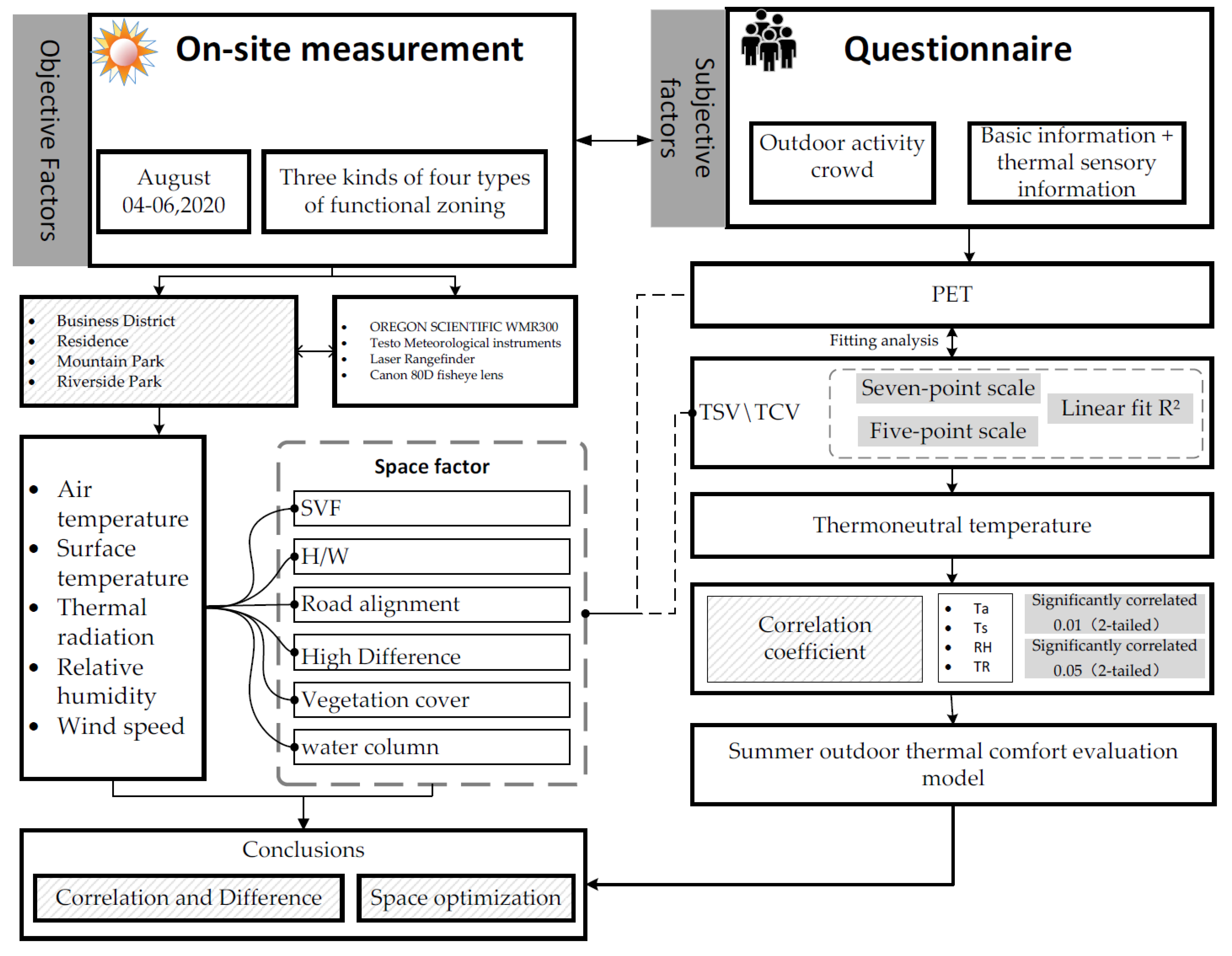
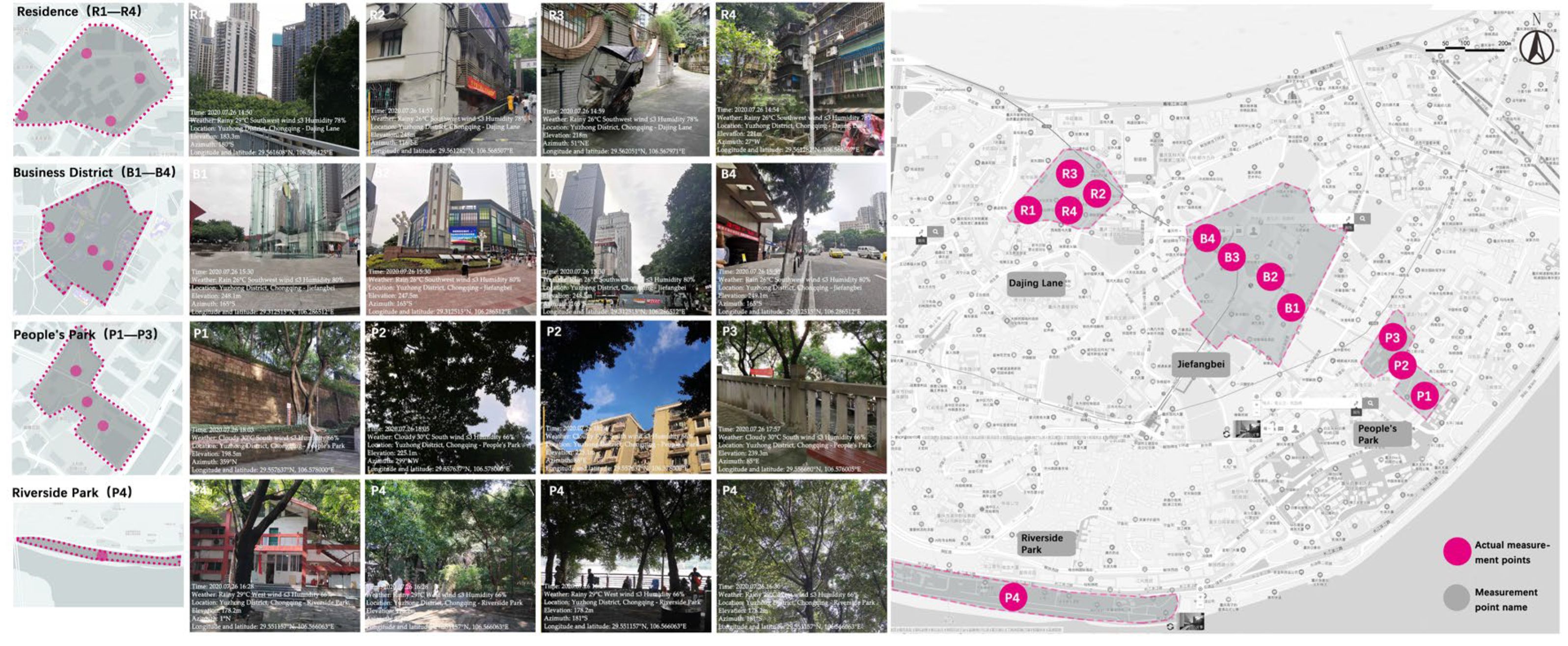


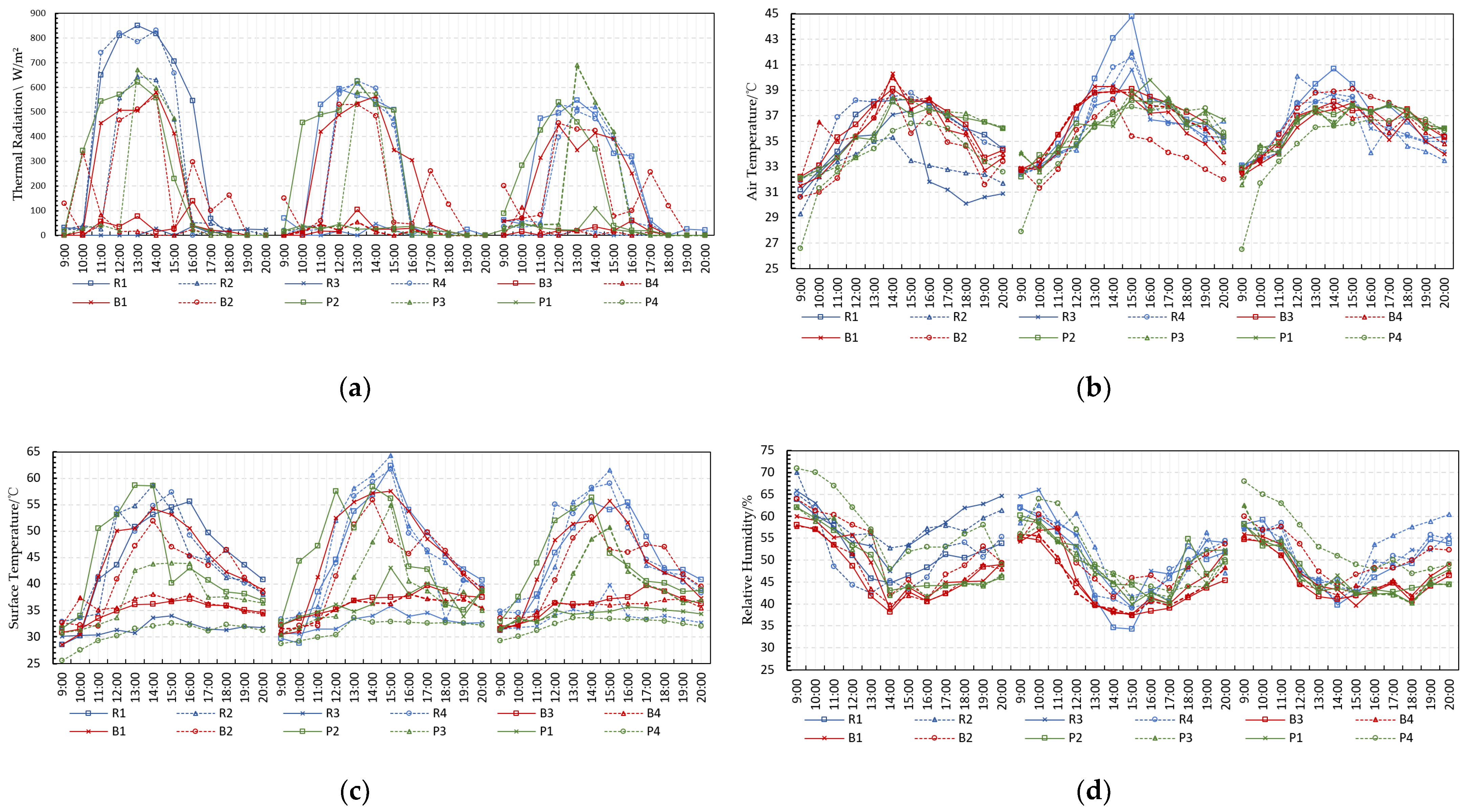
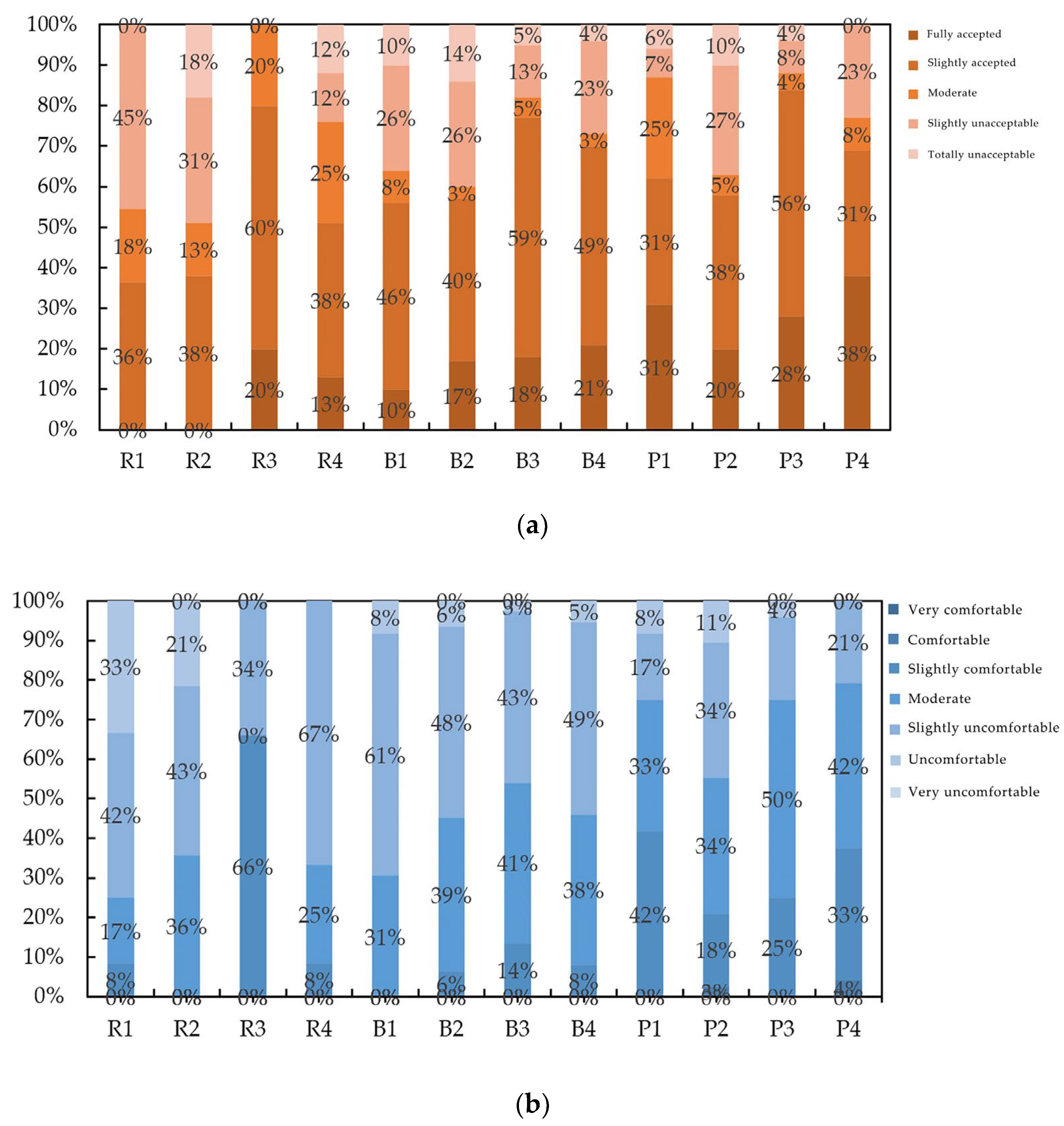


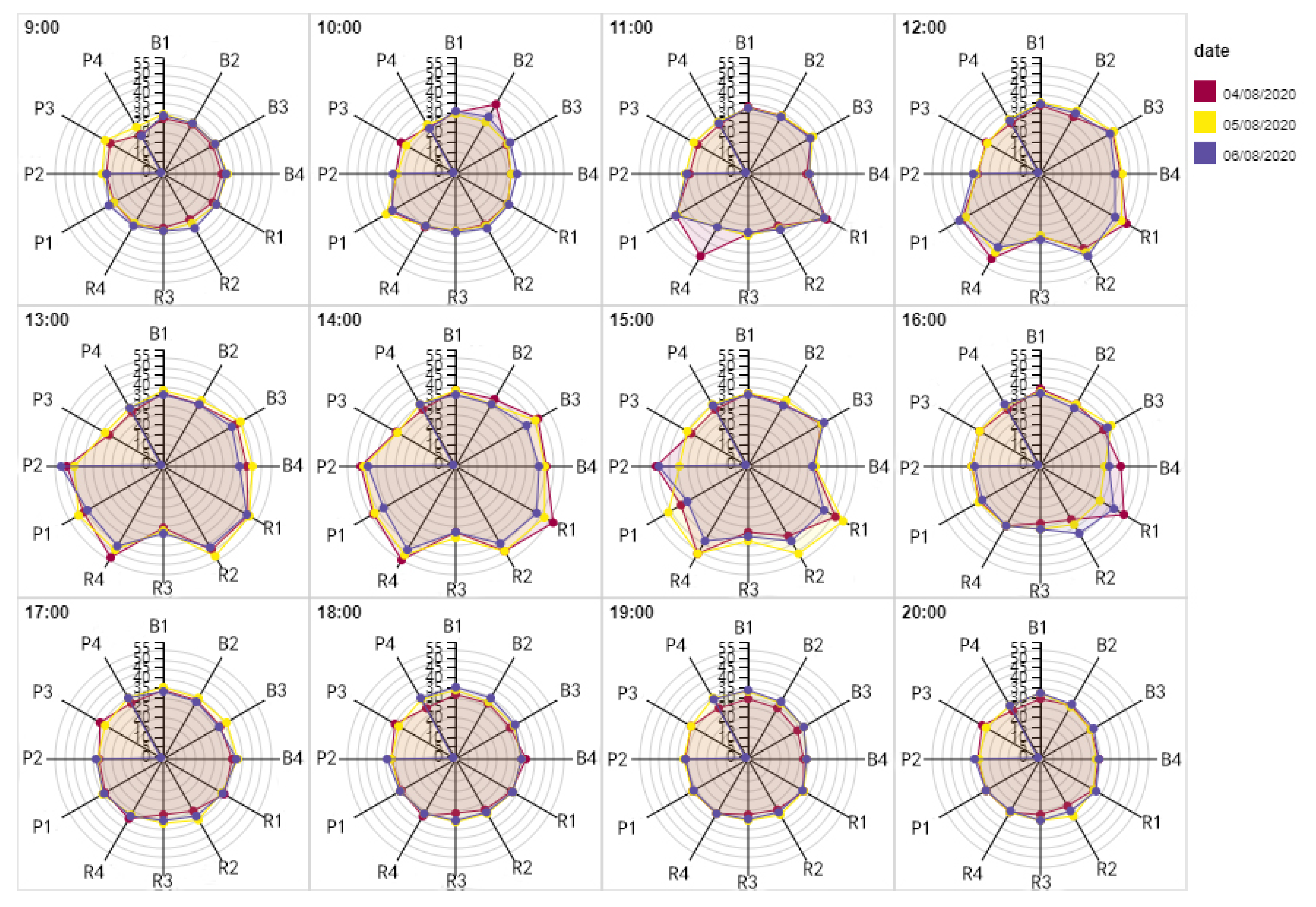
| 1 Road Alignment (Long Direction) | Height to Width Ratio/(H/D) | High Difference/m (Measurement Points) | Sky View Factor (0–1) | |
|---|---|---|---|---|
| Business District (Jiefangbei) B1, B2, B3, B4 | 135° | 3.49 | 1.6 | 0.566 |
| Residence (Dajing Lane) R1, R2, R3, R4 | 160° | 0.45 | 64.7 | 0.301 |
| Mountain Park (People’s Park) P1, P2, P3 | 45° | 0.50 | 40.8 | 0.381 |
| Riverside Park (Riverside Park) P4 | 15° | 1.65 | 0.0 | 0.258 |
| Dajing Lane | Jiefangbei | Riverside Park | People’s Park | ||
|---|---|---|---|---|---|
| Air Temperature/°C | Max | 44.8(36.7) | 40.3(35.6) | 37.4(34.5) | 38.2(36.0) |
| Min | 31.2(33.2) | 31.5(32.9) | 26.6(29.1) | 32.1(33.2) | |
| AVG | 35.7 | 35.8 | 34.8 | 35.1 | |
| Relative Humidity/% | Max | 68.8(54.3) | 60.0(47.2) | 70.0(53.4) | 62.0(48.6) |
| Min | 42.8(45.6) | 37.7(40.1) | 43.0(47.5) | 40.1(42.6) | |
| AVG | 52.3 | 47.6 | 53.4 | 48.4 | |
| Wind Speed/(m\S) | Max | 0.4(0.1) | 3.4(1.7) | 3.1(1.5) | 1.5(0.3) |
| Min | 0.0(0.0) | 0.2(0.4) | 0.0(0.6) | 0.0(0.1) | |
| AVG | 0.3 | 0.9 | 1.5 | 0.4 | |
| Thermal radiation/W/m2 | Max | 850.0(487.3) | 581.0(329.2) | 0.0(0.0) | 690.0(440.0) |
| Min | 0.0(0.0) | 0.0(0.0) | 0.0(0.0) | 0.0(0.0) | |
| AVG | 180.9 | 111.1 | 0.0 | 98.2 | |
| PET/°C | Max | 37.5(30.8) | 48.6(36.5) | 36.1(31.5) | 49.7(37.6) |
| Min | 26.7(28.2) | 28.2(30.1) | 22.6(26.5) | 26.6(29.9) | |
| AVG | 34.2 | 36.4 | 32.1 | 37.6 | |
| Measurement Points | PET | TR | Ta | Rh | LST | ||
|---|---|---|---|---|---|---|---|
| B1 | PET | Pearson correlation | 1 | 0.634 * | 0.972 ** | −0.915 ** | 0.639 * |
| Sig. (2-tailed) | 0.027 | 0.000 | 0.000 | 0.025 | |||
| B2 | PET | Pearson correlation | 1 | 0.469 | 0.948 ** | −0.842 ** | 0.604 * |
| Sig. (2-tailed) | 0.124 | 0.000 | 0.001 | 0.037 | |||
| B3 | PET | Pearson correlation | 1 | 0.928 ** | 0.926 ** | −0.717 ** | 0.916 ** |
| Sig. (2-tailed) | 0.000 | 0.000 | 0.000 | 0.000 | |||
| B4 | PET | Pearson correlation | 1 | 0.963 ** | 0.952 ** | −0.724 ** | 0.701 * |
| Sig. (2-tailed) | 0.000 | 0.000 | 0.008 | 0.011 | |||
| R1 | PET | Pearson correlation | 1 | 0.938 ** | 0.788 ** | −0.689 * | 0.694 * |
| Sig. (2-tailed) | 0.000 | 0.002 | 0.013 | 0.012 | |||
| R2 | PET | Pearson correlation | 1 | 0.906 ** | 0.921 ** | −0.666 | 0.819 ** |
| Sig. (2-tailed) | 0.000 | 0.000 | 0.018 | 0.001 | |||
| R3 | PET | Pearson correlation | 1 | 0.356 | 0.845 ** | −0.838 ** | 0.874 ** |
| Sig. (2-tailed) | 0.256 | 0.001 | 0.001 | 0.000 | |||
| R4 | PET | Pearson correlation | 1 | 0.959 ** | 0.779 ** | −0.673 * | 0.875 ** |
| Sig. (2-tailed) | 0.000 | 0.003 | 0.016 | 0.000 | |||
| P1 | PET | Pearson correlation | 1 | 0.815 ** | −0.042 | 0.041 | 0.708 ** |
| Sig. (2-tailed) | 0.001 | 0.897 | 0.898 | 0.010 | |||
| P2 | PET | Pearson correlation | 1 | 0.884 ** | 0.315 | −0.223 | 0.698 * |
| Sig. (2-tailed) | 0.000 | 0.319 | 0.487 | 0.012 | |||
| P3 | PET | Pearson correlation | 1 | −0.089 | 0.467 | −0.552 | 0.280 |
| Sig. (2-tailed) | 0.784 | 0.126 | 0.063 | 0.378 | |||
| P4 | PET | Pearson correlation | 1 | / | 0.952 ** | −0.864 ** | 0.910 ** |
| Sig. (2-tailed) | / | 0.000 | 0.000 | 0.000 | |||
Publisher’s Note: MDPI stays neutral with regard to jurisdictional claims in published maps and institutional affiliations. |
© 2022 by the authors. Licensee MDPI, Basel, Switzerland. This article is an open access article distributed under the terms and conditions of the Creative Commons Attribution (CC BY) license (https://creativecommons.org/licenses/by/4.0/).
Share and Cite
Huang, H.; Jie, P. Research on the Characteristics of High-Temperature Heat Waves and Outdoor Thermal Comfort: A Typical Space in Chongqing Yuzhong District as an Example. Buildings 2022, 12, 625. https://doi.org/10.3390/buildings12050625
Huang H, Jie P. Research on the Characteristics of High-Temperature Heat Waves and Outdoor Thermal Comfort: A Typical Space in Chongqing Yuzhong District as an Example. Buildings. 2022; 12(5):625. https://doi.org/10.3390/buildings12050625
Chicago/Turabian StyleHuang, Haijing, and Pengyu Jie. 2022. "Research on the Characteristics of High-Temperature Heat Waves and Outdoor Thermal Comfort: A Typical Space in Chongqing Yuzhong District as an Example" Buildings 12, no. 5: 625. https://doi.org/10.3390/buildings12050625
APA StyleHuang, H., & Jie, P. (2022). Research on the Characteristics of High-Temperature Heat Waves and Outdoor Thermal Comfort: A Typical Space in Chongqing Yuzhong District as an Example. Buildings, 12(5), 625. https://doi.org/10.3390/buildings12050625





